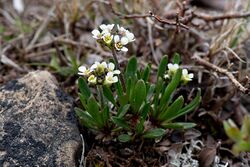Biology:Braya longii
| Braya longii | |
|---|---|

| |
| Scientific classification | |
| Kingdom: | Plantae |
| Clade: | Tracheophytes |
| Clade: | Angiosperms |
| Clade: | Eudicots |
| Clade: | Rosids |
| Order: | Brassicales |
| Family: | Brassicaceae |
| Genus: | Braya |
| Species: | B. longii
|
| Binomial name | |
| Braya longii Fernald
| |
Braya longii, common name Long's Braya or Long's northern rockcress, is a small, herbaceous, arctic-alpine flowering plant that grows only in the cool, wet and windy climate of the coastal limestone barrens of northern Newfoundland.[2] It is a narrow endemic, found in only five populations within a range of 6 km, and in one isolated population 14 km to the south,[2] all in the Strait of Belle Isle ecoregion on the extreme northwest portion of the Great Northern Peninsula of Newfoundland.[3]
Description
Braya longii is a small scapous (flower-stalk grows directly from the ground) perennial, with basal leaves that are fleshy and greyish-green to bluish in colour.[1] It stands erect at a height of 1–10 cm.[3] It is an obligate calciphile, meaning that it requires calcium-rich soil, and grows in limestone substrate disturbed by either natural (frost heave, wind or water erosion) or anthropogenic processes. The plant has a deep taproot for anchorage and moisture access, and dies back to the crown in winter.[3] The flowers are each connected to a central scape on stems often with a single leaf, and, like all members of the mustard family, each flower has four tall and two short stamens. White, four-petaled flowers, each with four oval, green to purple-tinged sepals arranged in a raceme,[2] have claws that are usually tinged with bluish- or reddish-violet.[1] Leaves are linear-spatulate,[2] with pointed ends, and measure 1–4 cm in length, 1–3 mm in width.[3]
Conservation status
Braya longii was listed as endangered under the Canadian Species at Risk Act in 1997 and the Newfoundland and Labrador Endangered Species Act in 2002.[3] Its principal threat is habitat loss due to extensive limestone quarrying, road construction and community development. Off-road vehicle use also threatens the plant's habitat, as do road and utility maintenance and climate change. Survival and reproduction are threatened by a non-native herbivorous insect, the diamondback moth, and three microbial pathogens.[3]
References
- ↑ 1.0 1.1 1.2 "Species Profile: Long's Braya". Government of Canada. http://www.sararegistry.gc.ca/species/speciesDetails_e.cfm?sid=6. Retrieved 11 June 2016.
- ↑ 2.0 2.1 2.2 2.3 Squires, Susan E., Luise Hermanutz and Peggy L. Dixon (April–June 2008). "Endangered, Endemic and almost Invisible – Rare Braya on the Limestone Barrens of Newfoundland, Canada". Endangered Species UPDATE 25 (2): 41. http://www.umich.edu/~esupdate/aprjun2008/Braya.pdf. Retrieved 11 June 2016.
- ↑ 3.0 3.1 3.2 3.3 3.4 3.5 "Recovery Strategy for Long's Braya (Braya longii) and Fernald's Braya (Braya fernaldii) in Canada". Government of Canada. http://publications.gc.ca/collections/collection_2012/ec/En3-4-119-2012-eng.pdf. Retrieved 11 June 2016.
Wikidata ☰ Q15537536 entry
 |


